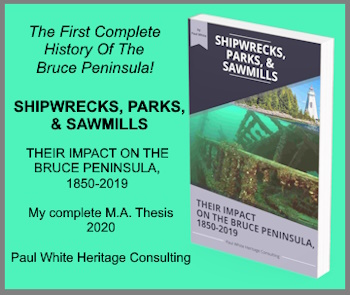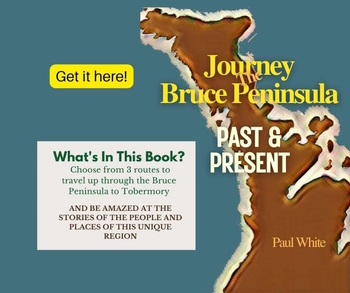My newest book, "Hockey In The Forest City: London's Story" SEE IT HERE!
Cutting Trees
in the Queen's Bush
Cutting Trees in the Queen's Bush was often an arduous task for settlers clearing their parcel of land to meet their land grant obligations.
This past Sunday, not only this area, but all of Ontario experienced terrible windstorms.
As we sat in the relative safety of our homes tremendous gusts of wind wreaked havoc all around. At one point there was a loud crack and a huge limb fell from one of the giant maple trees on our front lawn.
Later in the day news reports told of the carnage left in the wake of the storm. We were lucky indeed compared to some communities in the American mid-west.
In our area there were reports of hydro poles being snapped in half like toothpicks, falling trees, and power outages. On Sunday afternoon as I drove into Owen Sound the roadway was strewn with branches and large trees on the ground. Many of them had been snapped from their trunk, as if they were only match sticks.
The sight of large trees ripped from their ancient moorings made me think of this area when the first settlers arrived here and I wondered if some of the larger fallen trees had been part of the original forests which blanketed this area in the 1840s.
Certainly, the size of some of them suggested they had weathered many storms over the decades only to succumb to this latest blast from Mother Nature.
When the first settlers arrived in this region, they faced a daunting task. Part of the terms of land grant that they had received from the colonial government required the clearing of the land by cutting the trees from the Queen's Bush and the erection of a permanent residence. Journals and diaries from the era of the first settlers report that the Queen's Bush being densely. covered by large trees.
An example of the density of the forest in this region, known as the Queen's Bush, occurred about 1842 when Ezra Brown arrived here from Montreal. A tanner by trade, Brown proposed building a tannery in the small clearing which marked the settlement of Sydenham. The other inhabitants of the community which was located in the general area of 8th Street East, where the City Hall and the Farmer's Market now stands, were repelled by the idea of a "smelly” tannery in their midst.
Consequently, they forced Brown to locate his business a good distance to the north om the midst of the forest.
The remote location, out of the sight and smell of the other citizens of the community was in the general vicinity of what would become in later years, near the intersection of 10th Street and 2nd Avenue Fast.
The forests in the area were extremely dense, and many early settlers often got lost when they ventured into the woods which surrounded the settlement. In order to aid travellers in finding their way to the clearing, gunshots were fired to signal the location of the community.
Many of the trees that blanketed the area were of tremendous size. Alan Ross in his wonderful book Reminiscences of North Sydenham described size of some of the trees that met the blade of the axe. He reported that one tree was eight feet in diameter at the ground and seven feet in diameter at the stump. It was 90 feet in height and that a settler might find as many as three or four of these giants on one acre along with all the other trees which covered land. This, indeed, must have made cutting trees in the Queen's Bush a daunting task!
When I returned home Sunday evening, I set to removing the fallen limb and branches from our large maple. Stirred with the idea of emulating the early settlers cutting trees in the Queen's Bush, I was almost pleased that it was too large to drag away. I grabbed my axe and I set about to chop up the huge limb into more manageable sizes.
I chopped and chopped, but the limb refused to give up its pieces. Slowly I made headway, but aching muscles forced me to retire from my task before it was complete.
Again, and again I have attacked that stubborn limb with my axe, but still it refused to give in.
I was beginning to doubt my abilities as an axe man, when at last, I came upon the reason why it was so difficult a task, The axes used the pioneers cutting trees in the Queen's Bush must have been of better quality than those available to us modern-day “lumber-jacks."
A version of this article originally appeared in my Local History column in the Owen Sound Sun Times.






